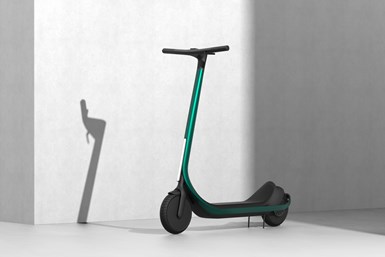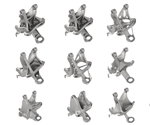Thermoplastic Composites Facilitate DED of Electric Scooter
The Scotsman scooter’s creators say it is the first fully custom, 3D printed electric scooter. The company uses Arevo’s Aqua DED system to print the carbon-fiber thermoplastic composite body.

All three variations of the first-generation Scotsman electric scooter are printed from carbon-fiber thermoplastics through Arevo’s Aqua DED system.
Photo Credit: Scotsman
Even as electric scooters arrive on city streets throughout the world, the designs and constructions are extremely similar. Scotsman, a company based in Milpitas, California, is using DED to launch a customizable alternative.
The company says its line of scooters will be the first 100% carbon-fiber thermoplastic composite electric scooters in the world, and that these scooters are customizable for the customer’s height, weight and riding style. The scooter has a unibody construction, eliminating the weaknesses of joints and glued components.
According to Josh Morenstein, founder of Branch Creative, the company that designed the Scotsman, “3D printing with carbon-fiber composite enables us to pursue designs not otherwise possible in other materials and fabrication techniques.”
Deposited Into Production
To produce the Scotsman, the company used Arevo’s Aqua DED (directed energy deposition) system, which is largely predicated on a deposition head mounted on a six-axis robot. The head uses a laser to melt the thermoplastic material, which is a mix of nylon and carbon fiber with a 50% nominal fiber volume, then compacts the material with a roller to eliminate voids in the structure. The printer’s build volume measures 1,000 × 1,000 × 830 mm.
Aqua uses Arevo’s Xplorator software, which enables topology optimization of the design, toolpath generation, control and other functions. Arevo is operating a printer farm in Ho Chi Minh City, Vietnam, to produce the Scotsman scooters.
What Qualifies as an Electric Vehicle?
While automotive is leading the charge to electrification, other kinds of vehicles that move people and/or products also fall under the EV category. READ MORE
Related Content
-
3D Printed Preforms Improve Strength of Composite Brackets: The Cool Parts Show Bonus
On this episode, we look at a pin bracket for the overhead bin of an airplane made in two composite versions: one with continuous fiber 3D printed reinforcements plus chopped fiber material, and one molded from chopped fiber alone.
-
Louisville Slugger Uses Formlabs Technology to Accelerate Innovation
Louisville Slugger relies on Formlabs’ Form 3 stereolithography 3D printer to create both prototypes and manufacturing aids for designs of the composite and aluminum bats swung by youth and collegiate players.
-
Video: Reinforcing (and Joining) Parts After 3D Printing
Reinforce 3D has developed a method that can be applied to strengthen 3D printed parts by feeding continuous fiber and resin through them. The technique also enables joining parts of various materials and manufacturing methods.

.jpg;width=70;height=70;mode=crop)









